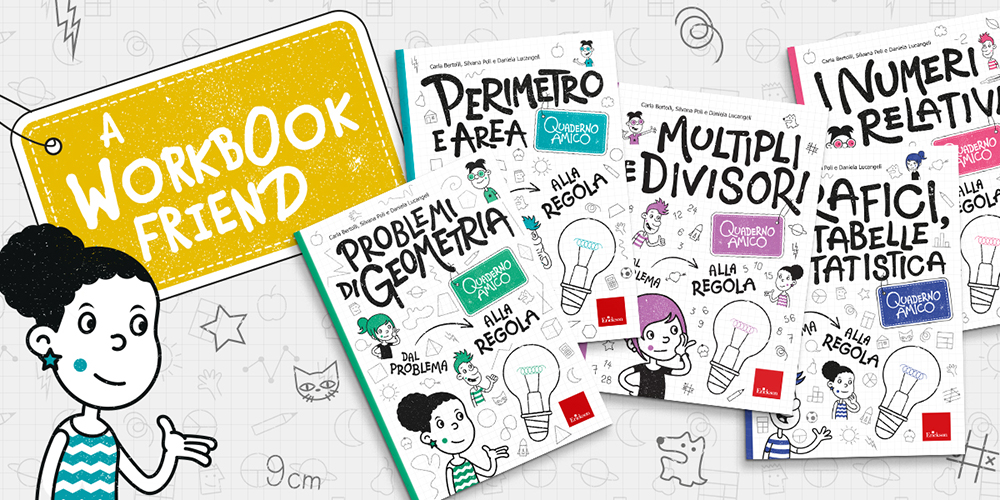 EN
EN
 PT
PT
From the problem to the rule
Product: Book
Trim size in cm: 21x29,7cm
Pages: 112
ISBN: 9788859031475
Publication date: 01/05/2023
Suitable for: Lower secondary 1st level (ages 10-11), Lower secondary 2nd level (ages 12-13)
REQUEST A SAMPLE OR MORE INFORMATION
Starting each time from concrete situations, initially very simple and gradually more complex, this workbook involves lower secondary school children in the “construction” of rules and concepts to learn how to use graphs, tables and statistical calculations. A Workbook Friend – Graphs, tables and statistics proposes problem-stories drawn from the everyday life and experience of children to activate a metacognitive reflection about: the function of graphs, tables, statistical calculations and the procedures and semantics they imply. Starting from the problem-situation, the function of graphs, tables and statistics and of the connected calculation are grasped intuitively.
The book is divided into two parts. The first part contains activities for “building” knowledge and consists of 10 worksheets labelled “Experiment.” The second part contains structured exercises for consolidating knowledge already acquired and consists of 10 worksheets labelled “Consolidate.”
Data
The tables
From table to histogram
From table to pie graph and ideogram
From table to empirical graphs
From table to graphs on the Cartesian plane
Statistics: mode, median and mean
Statistics: calculation of probabilities
Statistics: combinatorics
Graphical solution problems

With Giulia, Marty, Teo and Luca, mathematics becomes child's play!
Workbook Friend is a series of practical books, edited by Silvana Poli, Carla Bertolli and Daniela Lucangeli, amongst the greatest experts in the psychology of learning, designed as handy tools to accompany lower secondary school students and those in their last year of primary school in their acquisition of basic mathematical competences.

How they are structured
Each book is divided into two parts:
The methodology: from the problem to the rule
The methodology can be summarised as follows:
In brief:
The learning process «from the problem to the rule» enables pupils to «build» logical mathematical concepts themselves. The latter are «traditionally» received in an already formalised way and conveyed mainly through verbal instead of visual and practical communication. In this way, pupils are motivated in their search for the result, which is also the solution to the problem. They are also better prepared to acquire, as class practice has demonstrated, greater command of the resolution mechanism.
The books:
• Geometry problems
Starting each time from initially very simple and gradually more complex concrete situations, this workbook involves boys and girls from lower secondary school in the "construction" of rules and concepts to solve geometry problems. More info »• Graphs, charts and statistics
Do you want to learn how to use graphs, charts and statistical calculations? Starting each time from concrete situations, the volume accompanies you in the construction and understanding of rules and concepts. More info »• Relative Numbers
What are relative numbers and what are they for? Taking its cue each time from problem situations, initially very simple and gradually more complex, this workbook involves lower secondary school students in the "construction" of the concept of relative numbers starting from real data. More info »• Perimeter and Area
What are Perimeter and Area for? Starting off with concrete situations and problems, students will “construct” the formulas used to calculate the perimeter and area of shapes. More info » Some pages from the book:
• Problems
What are problems for? Before solving problems, it is necessary to recognize that there are situations “to be solved”. Only after understanding this, can the child learn to identify problem-situations. More info » Some pages from the book:
• Measurements and equivalents
What are measurements and equivalents for? Starting off with concrete situations and problems, students will learn the rules and concepts of measurement of areas, volumes, capacities and weights. More info » Some pages from the book:
• Multiples and divisors
What are multiples and divisors for? Starting off with concrete situations and problems, the role of multiples, divisors and their calculation will be understood at an intuitive level. More info » Some pages from the book:
• Powers
What are powers for? Using their daily life experiences as a starting point, students will start thinking about the role of powers in math calculation. More info » Some pages from the book:
• Expressions
What are expressions for? Even though it is not often stated in maths books, expressions are used to solve concrete problems that present themselves in day-to-day life. More info » Some pages from the book:
• Fractions
What are fractions for? Based on their experience and knowledge of primary school, children may answer: «to divide a cake », «to use a tape measure», «to colour different parts». We are talking about explanations that are «simple» maybe but at the same time valid and plausible. More info » Some pages from the book: